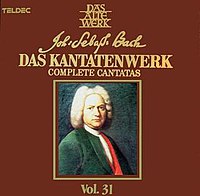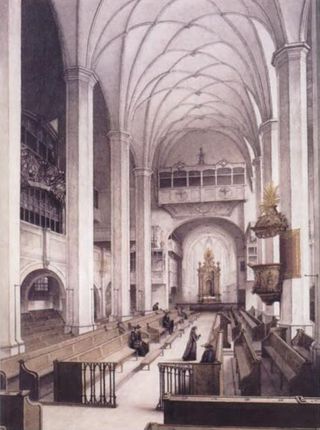
Meine Seufzer, meine Tränen, BWV 13, is a church cantata by Johann Sebastian Bach. He composed it in Leipzig for the second Sunday after Epiphany and first performed it on 20 January 1726.

Jesu, nun sei gepreiset, BWV 41, is a church cantata by Johann Sebastian Bach. He composed the chorale cantata in Leipzig for New Year's Day and first performed it on 1 January 1725 as part of his second cantata cycle. It is based on the hymn by Johannes Hermann (1591).
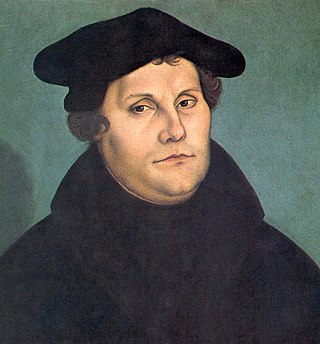
Johann Sebastian Bach composed the church cantata Nun komm, der Heiden Heiland, BWV 62, in Leipzig for the first Sunday in Advent and first performed it on 3 December 1724. The chorale cantata is based on Martin Luther's Advent hymn "Nun komm, der Heiden Heiland". It is part of his chorale cantata cycle.
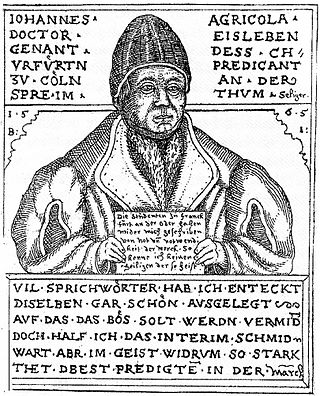
Johann Sebastian Bach composed the church cantata Ich ruf zu dir, Herr Jesu Christ, BWV 177. He wrote the chorale cantata in Leipzig for the fourth Sunday after Trinity and first performed it on 6 July 1732. The cantata text is formed by the unchanged five stanzas of Johann Agricola's hymn.

Max van Egmond is a Dutch bass and baritone singer. He has focused on oratorio and Lied and is known for singing works of Johann Sebastian Bach. He was one of the pioneers of historically informed performance of Baroque and Renaissance music.

Kurt Equiluz was an Austrian classical tenor. He was a member of the Vienna State Opera as a tenor buffo from 1957 until 1983, remembered for roles such as Pedrillo in Mozart's Die Entführung aus dem Serail. He appeared regularly at the Salzburg Festival, including world premieres such as Rolf Liebermann's Penelope in 1954. He recorded works by Johann Sebastian Bach with conductors such as Michel Corboz, Helmuth Rilling and Charles de Wolff, and prominently as the Evangelist in the first recording of Bach's St John Passion on period instruments with the Concentus Musicus Wien in 1965, conducted by Nikolaus Harnoncourt.

Ärgre dich, o Seele, nicht, BWV 186 is a church cantata by Johann Sebastian Bach. He composed it originally in Weimar in 1716 for Advent, BWV 186a, and expanded it in Leipzig in 1723 for the seventh Sunday after Trinity, where he first performed it on 11 July 1723.

Johann Sebastian Bach composed the church cantata Siehe zu, daß deine Gottesfurcht nicht Heuchelei sei, BWV 179 in Leipzig for the eleventh Sunday after Trinity and first performed it on 8 August 1723.

Johann Sebastian Bach composed the church cantata Lobe den Herrn, meine Seele, BWV 69a, also BWV 69.1, in Leipzig for the twelfth Sunday after Trinity and first performed it on 15 August 1723. It is part of his first cantata cycle.

Johann Sebastian Bach composed the church cantata Ihr, die ihr euch von Christo nennet, BWV 164 in Leipzig for the 13th Sunday after Trinity and first performed it on 26 August 1725.
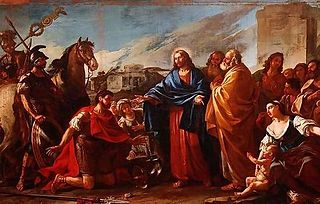
Johann Sebastian Bach composed the church cantata Ich glaube, lieber Herr, hilf meinem Unglauben, BWV 109, in Leipzig for the 21st Sunday after Trinity and first performed it on 17 October 1723.

Mein Gott, wie lang, ach lange?, BWV 155, is a church cantata by Johann Sebastian Bach. He first performed it in Weimar on the second Sunday after Epiphany, on 19 January 1716.

Nimm, was dein ist, und gehe hin, BWV 144, is a church cantata by Johann Sebastian Bach. He composed it in Leipzig for the Sunday Septuagesimae, the third Sunday before Lent, and first performed it on 6 February 1724.

Erhöhtes Fleisch und Blut, BWV 173, is a church cantata by Johann Sebastian Bach. He composed it in Leipzig for Pentecost Monday and probably first performed it on 29 May 1724.
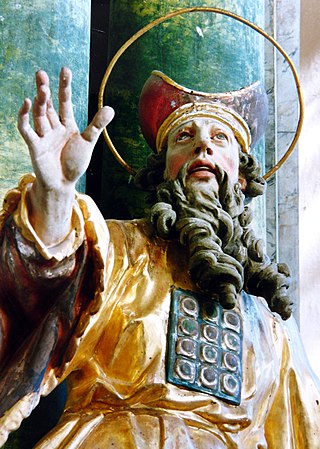
Johann Sebastian Bach composed the church cantata Ihr Menschen, rühmet Gottes Liebe, BWV 167 in Leipzig for the Feast of St. John the Baptist and first performed it on 24 June 1723. It is part of his first cantata cycle in Leipzig.

Meinen Jesum laß ich nicht, BWV 124, is a church cantata written by Johann Sebastian Bach. He composed the chorale cantata in Leipzig for the first Sunday after the Epiphany and first performed it on 7 January 1725. It is based on the hymn "Meinen Jesum laß ich nicht" by Christian Keymann.

Was mein Gott will, das g'scheh allzeit, BWV 111, is a cantata by Johann Sebastian Bach for use in a Lutheran service. He composed the chorale cantata in Leipzig in 1725 for the third Sunday after Epiphany and first performed it on 21 January 1725, as part of his chorale cantata cycle. It is based on the hymn by Albert, Duke of Prussia, published in 1554, on the topic of the Christian's acceptance of God's will.
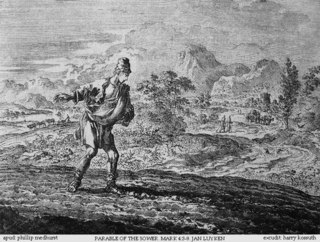
Leichtgesinnte Flattergeister, BWV 181, is a church cantata by Johann Sebastian Bach. He composed it in Leipzig for Sexagesima and first performed it on 13 February 1724.

The Bach cantatas project of Ton Koopman was the first complete recording of all the cantatas, including the 21 secular cantatas. Koopman conducted the Amsterdam Baroque Orchestra & Choir and guest solo singers. The project began in 1995 and was completed in 2005 on 67 CDs.
Bach composed Wie schön leuchtet der Morgenstern, BWV 1, as chorale cantata for the Marian feast of the Annunciation, for a first performance in a church service in Leipzig on 25 March 1725. The cantata, for soprano, tenor and bass soloists, four-part choir and Baroque orchestra, takes around 25 minutes to perform.
